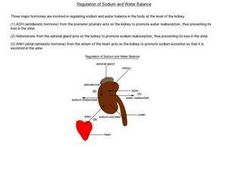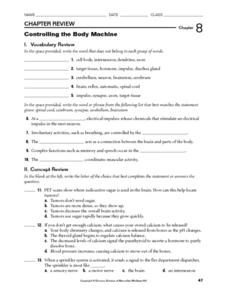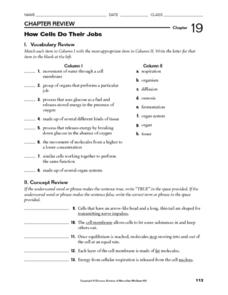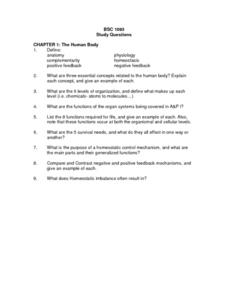Curated OER
Regulation of Sodium and Water Balance
In this regulation of sodium and water balance worksheet, students read notes about the three major hormones that are involved in regulating sodium and water balance in the body at the level of the kidney. Students view the given diagram...
Curated OER
How Food Moves Through the Body
In this food and digestion worksheet, students read a short article the digestive system and choose the multiple choice answer for 11 questions. Students also put the organs that food moves through in the correct sequential order.
Curated OER
Contraception
In this contraception worksheet, students learn about 4 methods of birth-control. They use the 6 words in the word bank to identify and label the birth-control diagrams. Students then list 4 methods of birth-control and list advantages...
Curated OER
Circulation
In this circulation worksheet, students review the circulatory system including the structures and functions of this system. This worksheet has 5 word scramble, 4 short answer, 1 fill in the blank, and 6 true or false questions
Curated OER
Controlling the Body Machine
In this nervous system worksheet, students review the parts of the body that make up the nervous system and how this body system works. This worksheet has 5 fill in the blank, 5 matching, 3 multiple choice, 5 true or false, and 3 short...
Curated OER
Moving the Body
In this musculoskeletal system worksheet, students review the function of bones and muscles in this body system. Students also review the different types of muscles: smooth, skeletal, and cardiac. This worksheet has 10 fill in the blank...
Curated OER
The Respiratory and Urinary System
In this body systems worksheet, students read information about the processes involved in the respiratory and urinary systems. Students then answer 1 short answer and 2 multiple choice questions.
Curated OER
The Nervous System and the Effects of Drugs
In this nervous system worksheet, students read information about how the body receives and sends out information through the peripheral nervous system and central nervous system. Then students complete 3 short answer questions.
Curated OER
The Circulatory System
In this circulatory system worksheet, learners review the functions of red blood cells, white blood cells, and platelets. Students label the parts of a human heart on a diagram. This worksheet has 4 short answer, 13 matching, and 9 true...
Curated OER
Fueling the Body
In this nutrition worksheet, students review the organs and enzymes that are part of the digestive system. Then students review the food pyramid by comparing two menus. This worksheet has 9 fill in the blank, 4 true or false, and 5 short...
Curated OER
Respiration, Circulation, and Excretion
In this body systems activity, students read information about the respiratory, circulatory, and urinary system and then complete 5 short answer questions.
Curated OER
Defense Against Infectious Diseases
In this infectious disease defense worksheet, students will review the immune system including acquired, antibody, and cellular immunity. Students will then compare passive and active immunity to infectious diseases. This worksheet has...
Curated OER
Protection, Support, and Locomotion
In this vertebrate skeleton worksheet, students will read a paragraph about the function of bones, muscles, and skin. Then students will complete 6 short answer questions.
Curated OER
The Human Body
In this human body activity, students will review the characteristics of the body systems: skeletal, circulatory, muscular, digestive, urinary, endocrine, reproductive, lymphatic, and respiratory systems. This activity has 12 fill in the...
Curated OER
Preventing and Treating Disease
In this disease worksheet, students will review the organs associated with the immune system including their specific functions. This worksheet has 10 matching, 8 true or false, and 5 short answer questions.
Curated OER
Protection, Support, and Locomotion
In this skeletal system worksheet, students will read a graphic organizer and complete 1 short answer question about the five functions of the skeleton. Then students will use a graphic organizer about muscle types to fill in a table...
Curated OER
Protection, Support, and Locomotion
In this human body activity, students will review 5 terms associated with the skin by filling in the blank. Then students will read 14 statements about the human skeleton and muscles and determine if its true or false.
Curated OER
How Cells Do Their Jobs
In this cells worksheet, students will review cell characteristics and structure and different types of cells and what role they play in the body. Students will investigate experimental results of the influence of sucrose on the...
Curated OER
Word Search Puzzle: Body Parts
In this body parts activity, 3rd graders will focus on vocabulary associated with the body. Students will complete a word search and find the 22 words that are listed below the puzzle.
Curated OER
Cardiovascular System Definitions and Study Questions
In this cardiovascular system study question worksheet, students define 21 words associated with this system. They answer 16 short answer questions related to circulation of blood through the body.
Curated OER
The Human Body Study Questions
In this human body study question worksheet, students define 6 words associated with the human body. They answer 8 short answer questions about the organization and function of the organ systems and organization structure of the human body.
Curated OER
Central Nervous System Study Questions
In this central nervous system worksheet, students define 24 terms associated with the human central nervous system. They answer 28 short answer questions dealing with the structures and function of the CNS.
Curated OER
Your Lymphatic System
In this lymphatic system worksheet, students describe whether they think that the lymphatic system is well-adapted to carrying material through the body in comparison to the circulatory system. Then they design a lymphatic system for an...
Curated OER
Your Digestive System
In this digestive system worksheet, 9th graders identify and explain any difference found in color of the mixtures in two glasses. Then they determine what enzyme was produced by glands in the mouth changing the starch in a chewed cracker.

























